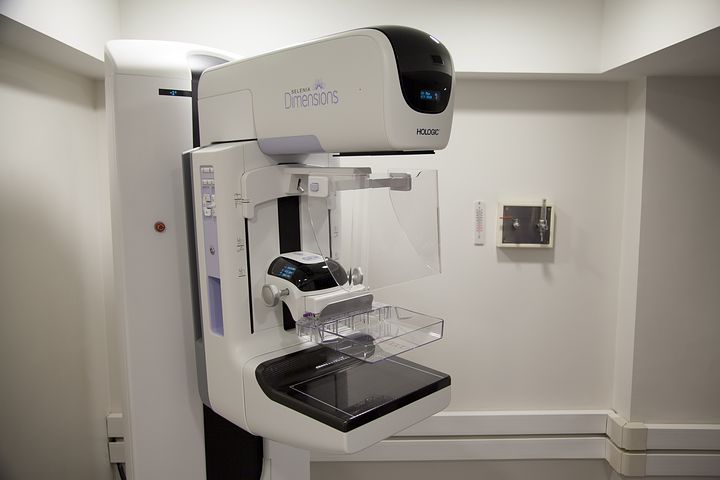
Why Does No One Want To Go Into Mammography?



Radiology residents, especially, are under the gun to complete their work efficiently. I mean, to learn what you need to know for the boards you have to read through umpteen books and a gazillion films, right? So, who has the time to go through the motions of a bland long-winded study routine to get you through all the material? That would take way too long. Therefore, I want to give you some suggestions to guide you efficiently through all the subjects you need for radiology residency. So, here are some the basics you need to get through residency with minimal effort and maximal gain!
I can’t remember the number of times that I have talked about targeted reading in my posts. But, I will repeat it for the ten thousandth time. It’s that important. Every resident should read radiology books differently from other subjects. Remember. Pictures first, then captions, and then text. If you start from the text and go to the images, much less information will stick. So, please do yourselves a favor and do this the right way.
And, just as critically, make sure to emphasize case review series in your review process. Radiology without cases is like peanut butter without the jam (sorry for those of you that are allergic to peanut butter!). It just does not feel right!
How do you get information to stick around in your brain? Well, you need to look at the same item from different angles. What do I mean by that? If you find a meningioma on a CT scan at work, first of all, make sure to look it up that night. Then, look at the same case on multiple imaging modalities. Perhaps, check it out on an MRI, a contrast-enhanced CT scan, or even a skull series if available. The more ways that you look at the same findings, the more likely you will recall the case when you need it!
Don’t let the texts that you are reading become merely a bunch of random words. Just like any other time that you had to study for tests, make sure to phrase the text into the form of questions. And, I have some great ideas to help you along your way. My residents reported using several test question bank companies for study, especially around board time. But, it may not be a bad idea to use these question banks at any time during your studies to emphasize the materials.
The two companies that I hear assist the residents with fairly comprehensive question banks are as follows: Board Vitals and Quevlar. Both of these companies give you some great questions for the Core Examination. Now, you need to make sure to have learned the basics before. But, both Board Vitals and Quevlar will enable to get through the material that much quicker to get you where you need to be before the boards.
You certainly need to read a lot independently to learn the material that you need to know. However, you should also utilize your colleagues to maximize your knowledge. Going over questions or cases in groups with your fellow residents adds new perspectives on the same information. And, by golly, here you have another neural pathway to maximize what you retain!
I believe in learning from numerous different angles. And, therefore, I need to put a pitch in for Board Review Courses. Not all program directors believe in this approach. However, sometimes, it helps to step out of your familiar residency conference world and to get a fresh perspective. Different instructors and different points of view create distinct neural pathways for information recall. That is the reason I believe a board review course can work. I think it’s not a bad idea to attend one or two.
Don’t get me wrong. To be a great radiologist, you need to put in the hours. However, make sure that you utilize your time as effectively as possible. Why spend time that you don’t have? So, follow this approach to get through the material logically and efficiently. Who doesn’t like minimal effort for maximal gain?

Hi, I saw your post and talking to all the programs in the south this year, radiology was less competitive with our program receiving 60-80 fewer applications than last year. I state this because this year was not more competitive. But if you check the NRMP and look at the numbers instead of writing from your gut, you would not spread false information.
I will take a page from Barry and speak from my gut and say it is getting less competitive in the next few cycles with the horrors of taking candidates with no inclination for radiology via the SOAP to only fail the boards will start again. In retrospect, I wish that I had interviewed more students because many have already been to 20-30 places with their prepared responses.
Fellow program director
Not quite sure if y0u are a real program director since you did not leave an email or another way to contact you. Most folks that are “real” will put their money where their mouth is. Additionally, the grammar was horrible (so I took the liberty to edit it a bit), and the note was challenging to read. (But that does not disqualify you from being a program director!) Regardless, I thought it would be fun to reply to this email in an ask the residency director format, now that we know our program has matched all four spots. So, here we go!
First of all, the NRMP has not released any of the numbers about the 2019 match. They are not yet available. Can’t say that I know what figures you are talking about from the NRMP. (another red flag regarding the credibility of your post!) However, I find it interesting that you reported having 60-80 fewer applications this year. That statistic flies right in the face of what our program has experienced for this year’s match. And, it also differs from what I have heard other programs saying. But, then again, we will find out the actual numbers of the match statistics when the real NRMP releases the stats for this year.
Second, my article called 2018-2019 More Competitive For Radiology? A Midyear Perspective is just a perspective. I based it on the hard and soft facts of what we saw at our program at the time of the article. I use pieces of evidence to support the conclusion that this year was more competitive, not gut reactions. But again, we will see if my prediction bears out when we do get the final word from the NRMP.
Next, I want to put a pitch in for those folks that will be matching in the SOAP. What you are implying about the SOAP candidates could not be further from the truth. Our former residents that matched through this process have been some of the most dedicated and fervent radiology residents that we have ever had. Most residents that match through the SOAP do not fail their boards. To the contrary, these residents perform extraordinarily during their four years and beyond.
And, finally, I am sorry to hear that you wish you should have been interviewing more students. (if you are real!) I think that says more about your program and your region of the country than the state of the radiology match this year.
Too-da-loo,
Barry Julius, MD

By the time you start your first radiology attending job, you should feel comfortable getting through a typical day’s work. So, how do you arrive at this point of comfort? Well, it is not via magic. Most successful starting radiologists will have adopted a formula for getting through a day’s trials and tribulations. Moreover, they know how to manage the worklist. And, the easy way to do so? You should have that experience during your radiology residency.
Now, not all residency programs work the same. Some residents plow through whatever cases the attending tell them to go through. In these sorts of residencies, the attending maintains the responsibility for the worklist. They make sure that either the resident or the attending read through the cases that they need to complete.
And at others, the resident starts the day by gathering the necessary cases together and dictating. Attendings will intermittently arrive at the department to read out the studies with the resident. However, the attending charges the resident with the responsibility of getting through the worklist for the day.
I would argue that the latter programs tend to be more helpful for starting in practice. Let me tell you why.
Most Practices Are Run By Radiologists
First of all, in most practices, who is in charge of the worklist? No, it is not the nurse, the technologist, or the radiology assistant. Instead, usually, the radiologist manages the worklist to determine who he should read first, second, and third. Even though artificial intelligence may one day take over some of this process, radiologists should have the background to feel comfortable owning a worklist.
Teaches You How To Get Help From Others
Let’s say that you start on your worklist and you find a case where you are not sure of the diagnosis. Who do you approach? And, how do you contact that person? Do you call or walk over to the other room? Do you interrupt their train of thought or do you wait until they finish up? Or, do you find a clinician in another specialty? These skills only come when you have to manage cases outside of your purview. And, these cases are much more likely to arrive when you control your worklist.
Learning How To Triage Work
In the same vein, when you have an unsorted worklist, how do you know what needs to be read first, second, and third? Sometimes, you arrive at a decision best when you have had the experience to make that conclusion. It takes time to figure out that you should read certain physician’s cases first or a specific type of STAT indication sooner. What better way than to manage a worklist as a resident?
Time Management Skills
Of course, when you learn to control your worklist, in the beginning, you may not realize how much time you have to complete all the work for the day. Unfortunately, you may find that you had less time than you initially thought. So what is the best way to hone your time management skills? Manage the worklist! You’ll eventually learn the ropes.
Patient And Physician Phone Calls
During the day, you are bound to receive multiple phone calls from both referring physicians and patients alike. How do you deal with them in the confines of a busy day when you have a whole bunch of studies to read? Well, when you manage your worklist, you get to figure that out. Do you spend an inordinate amount of time on the phone or do you hurriedly give them an answer? To determine how you should proceed, take charge of the work for the day!
It’s more than just lip service. Owning the worklist allows budding radiologists to hone their skills. Whether it teaches you to work with others, time management, the art of triage, or more, it will enable you to get through the day in a timely fashion. More importantly, when you learn all the skills of managing a worklist, you can hit the ground running at your first job. That’s where you want to be!

As physicians, we rely heavily upon our boards to verify that members of our profession can competently practice medicine. Nowadays, physicians are questioning whether the requirements for maintenance of certification (MOC) provide a valid measure of competency to practice radiology. Even in areas like internal medicine and radiology, a few physicians are taking this mission to court. (1)
But that’s just MOC for attending radiologists. What about the initial exam that the academics created to ensure that residents are competent to practice medicine, the core examination? Did the test creators correlate these board exams with minimal practice competency when residents finish training? And, is it even possible to do so? Moreover, what are these exams testing? Today I am going to provide a voice for the unloved residents that can’t vocalize their concerns about the examination due to the potential for reprisal from their faculty.
In doing so, I am going to investigate some of the biases that board creators such as the American Board of Radiology (ABR) face. And, then I am going to give some ideas our governing board can objectively use to assess minimal competency, not the current more subjective assessment of what the minimum skill sets should be.
If we think about how the ABR makes its core exam, they farm out experienced voluntary member radiologists of the ABR to create questions for the examination, most of which are academics. Herein lies the first problem. Who are the majority of the radiologists in the country? Are they academic radiologists? Simply put, no.
So, when the initial test question creators formulate the exam, they do not base their questions on the basic competency levels of all radiologists. Instead, these test creators may base their test questions on their own academic experience. This experience may include fairly esoteric knowledge that only the academic radiologist may need. For instance, the question creator may be an academic radiologist that works in an esthesioneuroblastoma center of excellence. Therefore, this radiologist may emphasize a rare disease that most radiologists may never experience. And, you might see this question pop up on your examination even though it does not evaluate for minimal competency.
Also, some of the question designers may practice in a highly subspecialized area. These subjects may not apply to the future practice of a majority of the examinees. Do these questions test for minimal competency? Sometimes probably not. The core examination should more objectively test knowledge that addresses skill levels, not random factual or subspecialty competency.
According to the ABR, a candidate passes a test if she meets the minimum cutoff that the organization deems appropriate. No, they do not base it on a curve. But, the ABR does need to figure out how to base their minimum cutoff. So, with what exactly does the ABR correlate this minimum competency level? Well, they have to base it off something. To answer that problem, the test question makers assume that they know what the minimal level of competency should be. Well, I am not so sure that is an objective standard based on their different skills compared to the average Joe Radiologist.
So, what are some objective standards to which questions should correlate? Well, I can think of a few. Peer review in practice may be one such metric. If the radiologist is entirely off the curve and has passed the board exam, this would indicate that perhaps the examination was faulty. We can correlate the test to that.
What else might be an appropriate metric? Radiologists that cannot hold a job and has been fired by more than one practice. Think about it. If practices continue to let a radiologist go because he does not meet the standards, that is probably a useful measure. Why not use this as a way to correlate the appropriateness of the core exam questions?
Another measurement could be surveying physicians in other subspecialties to assess the competency of the practicing radiologist. If the preponderance of surveys shows poor clinical insight, I believe that would be another useful measure for determining competency.
And finally, perhaps you could use a metric such as multiple lawsuits far about the mean in a particular subspecialty. If a radiologist has been sued five times and the average in her specialty is one or two, that would be a red flag. You can see if the test questions correlate with this endpoint.
These are all potential valid endpoints that the ABR can use to correlation the test that would lend a sense of objectivity. Right now, I am only aware of the subjective criteria of a biased individual examiner of what a passing physician should know. Perhaps, we need to change this concept 180 degrees to assess true competency with objectivity.
Currently, the subjective determined minimum standard of the ABR core examination is not good enough. If we want to create a test that genuinely tests minimum competency, we have to create one with a basis of more objective criteria that associate with the quality of practicing general radiologists that have completed the exam. It will take time and maybe a difficult chore. But it may be well worth it to develop a test that we can rely on to make sure that residents who pass the exam have the minimal competency to practice radiology, instead of being an expert in test taking itself.

Hello!
I am a U.S. Allopathic medical third-year medical student who is highly interested in applying for a residency in diagnostic radiology. However, I am concerned that my Step 1 score (227) will hinder my application. I ultimately would like to return home to California. However, I do understand that some of the most competitive residencies are in the Westcoast. Other than improving on my Step 2 score, what other steps could I take to increase my chances of matching? Do away rotations help, especially since I’d like to return home to the Westcoast?
Thank you!
Let me start by answering the end of the question first because I have received several requests to find out about if away rotations work to enhance the application. So, I like to say that away rotations are a double-edged sword. On the sharp-edged side, if you are the type of person that is outgoing and forms spontaneous connections with the folks you work with, then an away rotation can work well. You will be memorable to the admissions committee in a good way. On the other dull-edged side, if you are timid or not very remarkable, an away rotation can work against you.
When the admissions committee meets at most institutions, the program coordinator and the residents will usually speak up and say that a candidate did or did not work well in the institution. If the residents and program directors do not get to know you well, that can become a red flag.
For California specifically, as of this more competitive calendar year, your scores may prevent you from getting through some of the screening protocols at the residency programs. California programs for anything has become more and more competitive. Not that a score of 227 is terrible, but residency programs do have lots of applications to screen. And, some use it as a prelim screening criteria. I would imagine that some institutions may have higher minimums and some not.
That said, I would not let your USMLE scores dissuade you from applying to any institution. Many programs will deem your number to be adequate depending on what else you have accomplished during your residency. And yes, an improved Step II score will help your application a lot.
Assuming that you are still in the midst of your third-year rotations, the best thing that you can do to bolster your application is to do well on your clinical rotations at this point. The Deans Letter is the most scrutinized piece of the application. So, anything that you can do to improve that would be high yield.
And finally, if you have some time, I would try to pursue a short radiology project or two during the rest of the year. What kinds of projects? Well, case reviews or quick retrospective studies would be the types of projects that you should look for specifically. These sorts of projects show interest in the field of radiology and give you significant involvement in the field. At the bare minimum, it will provide you some talking points during interview season. And, at best, they will give you a few published or presented projects before the application screening/interview season begins.
Regards,
Barry Julius, MD

Radiologists create dictations with two audiences in mind, for the clinicians that read the report, and also for the lawyers that may interpret the record if the case turns sour. Depending on the radiologist, he might attune the report mostly toward the clinician or may create a dictation primarily for the attorneys. Every radiologist emphasizes one audience or another along a broad spectrum.
However, walking too far toward either extreme can become problematic. Forgetting about legal issues can lead to lawsuits. And, wholly concentrating on the attorney in your dictations can lead to angry clinicians.
In the situation of radiologists who write solely for the attorney, the report impact patients negatively. Why? They dilute the effect of our reports to care for our patients. Moreover, they send the wrong message to our trainees while neglecting the Hippocratic Oath. These radiologists are essentially saying that the legal importance of our reports trumps the clinical care of our patients.
Neither do I believe that we should ignore the legal aspect of our dictations entirely. That would be professional suicide.
So, we should think carefully about for whom we are writing and how it affects both the trainees and the clinicians. Therefore, today I am going to talk about how creating reports for clinicians or attorneys can impact your message. And, then I am going to give you some guidelines to compose a balanced dictation.
So, what happens if we create dictations with the attorney as the primary reader? First, it dilutes the message that we want to give to the clinician. These dictations tend to emphasize all possibilities for the diagnosis versus the most likely diagnosis. We overemphasize findings for our attorneys instead of the clinicians that read them. In the end, clinicians are less likely to pursue the correct avenue.
Next, our reports become wordier and harder to understand. When you write for the legal system, you tend to add more caveats. We use terms like cannot be excluded. I find these reports less straightforward and much longer to read.
And finally, when we write for the legal system, we tend to recommend additional tests to protect ourselves. Perhaps, that 22-year-old female with a probable hepatic hemangioma on ultrasound will receive a full workup that she does not need in the interest of protecting our hide.
On the other hand, what happens when we write only for the intended audience, the treating physician? Well, first we tend to de-emphasize the less likely diagnoses. So, if the clinician does not make the rare diagnosis, and it was not in your report, an attorney will more likely find fault with your dictation. Some of these “clinical dictations” may neglect the zebras entirely.
And, more importantly, by neglecting the attorneys we expose ourselves to the possibility of a lawsuit. By mentioning an appendicolith in a normal-appearing appendix and not talking about the rare outcome of early appendicitis, you may go down the proverbial tubes.
Like everything else in this world, the key to making something useful is to strike that perfect balance. To create a reasonable mean between the two extremes you can create dictations referencing the most likely diagnosis with some mention of the more uncommon etiologies, emphasizing the different probabilities.
Moreover, make the dictations easier to understand without using too many caveats. Wordiness does not necessarily protect you from having an attorney use your report against you in a lawsuit.
Finally, you should strive to recommend further workup for the most likely diagnoses that will significantly impact patient care without going overboard, using the clinical data to help make the decision.
The bottom line: We need to remember in every report that a patient’s medical care is at stake. And, that battle, for us radiologists, is worth the fight. So, think twice before you create your dictation for only the referring clinician or the attorney that might read your report!

Hi,
Which is the radiology subspecialty with the best lifestyle and shortest/least taxing work hours? And how about lifestyle in body imaging?
From,
The lazy radiologist .
I love the question. Why? Because it reflects the purpose of my website: To get answers that no one else will give you!
In any case, as you may know, if you want to make good money, radiology is no longer a lifestyle specialty. Imaging volumes are up, and very few imaging centers will hire someone that cannot keep up with the work. And, if you are the owner of a practice, you will undoubtedly need to work hard. But, if you are willing to take lower pay and not work as an owner, then numerous lifestyle opportunities abound. Of course, you can always decide to work part-time three days a week and have a great lifestyle as a lazy radiologist! Most specialties will allow you to work part-time depending on the practice where you choose to look.
OK. So, let’s say that you are interested in working full time and want a relative lifestyle subspecialty. My recommendation to you would be to find something in the outpatient imaging sector. Typically, hospitals and urgent care centers that need radiologists to work on call will be significantly busier and will require you to work on off hours. And, being busy disrupts the whole lazy radiologist lifestyle thing!
Then, what are some of those specialties that are more conducive to outpatient imaging? My first thought would be breast imaging. First of all, you will find very few breast emergencies and call scenarios for a breast imager. Unfortunately, the daily volume of work can be difficult if you want to make a significant amount of dough. But, at least you may not have to take call!
What else? Teleradiology gigs will allow you to work on your own time when you want. Some of them have “dayhawk” needs. In this situation, you can have the ultimate flexibility if you decide upon this field. But, then again some teleradiology firms want night workers. That may not fit the bill for what you want so don’t choose that pathway if so!
Also, MSK imaging is not a bad choice for lifestyle-oriented radiologists. MR MSK imaging tends to be an outpatient phenomenon. And, you can find some outpatient centers willing to take on an MSK radiologist.
Body imaging would not be my first thought as a lifestyle specialty because most practices have expectations for you to read lots of studies and to do lots of procedures. Also, most practices will expect you to take call. However, certain workplaces do allow for a better lifestyle than others. You can find them if you look although they may not be lifestyle-oriented in the most “desirable” cities. (That’s just the way it is!)
Most other subspecialties also involve significant amounts of work and time. But, as you get on in years, you may also have more flexibility in choosing a more lifestyle-oriented pathway as well. For instance, many interventionalists become diagnostic rads and so and so forth. So, there is no reason why you can’t choose to change your “lifestyle” pathway along the way.
Finally, remember. To be good at anything takes a lot of work. So, you may need to sacrifice being a real expert for lifestyle. That’s just the way it is!
Hope that helps a bit,
Barry Julius, MD

We often hear about radiologist practices and radiologists who cannot seem to get along well with the hospitals with which they work. Perhaps, it is the revenge of the grade C student hospital executive? Maybe, it is the lack of capital intensive resources for the radiologists? Or could it be that some hospitals take every opportunity to cheat radiologists of their next dollar?
Sure, these factors may contribute to a bad experience of working with a hospital. But, I believe that these factors are not the leading causes of conflict. Instead, the answer is simple. Our mission differs sharply with the employers with which we work.
So, how exactly does the primary mission of the employed radiologist or the
What is it that radiologists want? Well, let me give you some sentiments from radiologists in the form of some familiar complaints.
“Constant phone calls are constantly interrupting my workflow.”
“We don’t have enough technologists to keep the workflow going in interventional radiology.”
“The PACs system went down again, and I can’t dictate any cases.”
And finally, of course, “How many times do I have to tell the technologist to complete the study!”
So, what do these complaints have in common? Basically, they are all saying the same thing. Radiologists want seamless workflow. And, if I had to think of the mission statement for a practicing radiologist, it would be, “let me do my work without interruption!
What about the hospital or imaging center owners? Well, let me give you some of their sentiments in the form of some statements.
“We need to get the SPECT-CT operational so that we can get new patients into the system.”
“Clinicians are continually complaining that radiologists are not getting the reports out in time!”
“We have several obstructionist radiologists that are refusing studies to clinicians. We need to talk to them!”
“The layout of the department is making it impossible for patients to get their tests promptly.”
So, what do these statements from the guys in the executive suite have in common? They all are about the bottom line of the hospital. Or, “how can we maximize revenue for the organization and decrease costs?”
Fortunately, most of the time both owners and radiology employees are on the same page. Hospital executives usually want to create a seamless work environment for the radiologist to improve revenues. Likewise, radiologists aim to bring in the most revenue possible for the organization by improving workflow. However, many times these two mission statements will butt heads.
Occasionally, increasing system revenue may mean impeding the workflow of the radiologist. For instance, the hospital sees that picking up the phone while in the midst of a busy rotation makes their clinicians happy. At the same time, it delays the readings of the radiologist. The hospital continues to allow this to happen.
Likewise, increasing efficiency of the radiologists sometimes costs more to the system than doing nothing. Maybe, the reading room is not ergonomic, and the hospital cannot see how the hospital expense will improve the bottom line.
And, herein lies the crux of the problem. How can we reconcile the two missions?
Both parties need to have skin in the game to solve the misalignment dilemma. Employed radiologists need to have some ownership stake in the operations of the hospital. And just as importantly, owners/managers performance should be tied to improving the seamless workflow of the radiologist. You can’t expect either an employee or a manager to implement changes actively without incentive or experience. In some institutions, minimal incentives exist for these liaisons. Additionally, some managers have little experience with understanding the radiologist’s workflow.
So, how can we allow hospitals and radiologists to have better relationships? Well, we need to align the fundamental misalignments.
First, radiologists should receive some compensation for increasing the revenues and decreasing departmental costs. Tying rewards based on increasing institutional profits make the radiologist more likely to find favor with less radiologist friendly policy but excellent institutional benefit.
Moreover, hospital/practice management should not hire a random secretary within the building at a lower cost to run the business side of the practice. They should find a seasoned business manager who understands the trials and tribulations of the radiologist. How frustrating can it be to have someone who has no clue about radiologist operations?
Additionally, hospitals should tie the business manager to the efficiency of the radiologist practice. How? They can create a reward system not just based on hospital goals, but instead meeting the efficiency goals of the radiologists as well.
You cannot expect two groups to be on the same page when some of the most critical goals of each organization differ so widely from one another. Instead, you need to marry the two organizations mission statements into one. Creating a system to align the priorities of both groups should be a top priority. And, hiring the appropriate individuals is critical. Let’s resolve the differences instead of complaining about what both hospitals and the radiologists do wrong!

Hello Dr. Barry Julius,
I am an M3 Osteopathic Medicine student. My interest in diagnostic radiology has drastically grown since I had the opportunity to shadow a few doctors. I was hoping to get your perspective on my situation.
Background:
– STEP1 score 244
– Research (5 publications with one first author. 3/5 were before Medical school)
– STEP 2 (have not taken yet)
Regarding diagnostic radiology, I can only apply to 30 institutions that offer H1B and accept DO students. Do you think that this number is optimal? Is it frowned upon to apply to another specialty as a back up since I have limited opportunities?
I greatly value your thoughts and opinion,
Canadian Osteopath
It’s not a question of what is optimal. More is better for a foreign grad. Unfortunately, most institutions will not look at H1B/DO candidates because each institution that sponsors an H1B candidate will have to undergo significant effort and expense. In the past, Saint Barnabas has opted not to take such candidates for that reason. The one exception was a candidate already accepted to another program within the system. However, Saint Barnabas usually avoids this situation. I think that the same situation applies to most other residencies as well. So, you will need to take what you can get and apply to those places that are willing to take on your situation.
When it comes to your credentials, they are excellent and sufficient for getting into radiology residency programs, But, it’s hard to say how everything will play out because of your H1B issue. Most residencies will choose other candidates first just because of the hardships of sponsoring an H1B. But, you never know and it is indeed still worth applying.
In terms of other programs, you should certainly go ahead and apply for the backups if this is what you want to choose. As I mentioned in another recent ask the residency post, you can easily rank multiple different residencies by tying the prelim and the advanced years together and classifying them as one entity in the system. I think that most residency programs will recognize that you need to rank other backup programs as well. But, make sure to let them know that you are interested in the field regardless of whether it is a backup or not.
Hope that helps a bit,

Join our mailing list for free to receive weekly articles and advice on how to succeed in radiology residency, the best ways to apply, how to have a successful radiology career, and more. Also, get a copy of the free ebook Called The New Attending Physician Guidebook: How To Search For The Right Job And What To Do Once You Start.